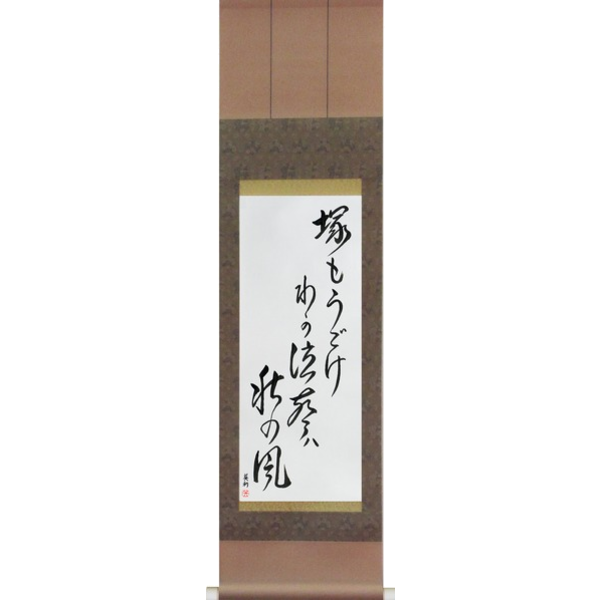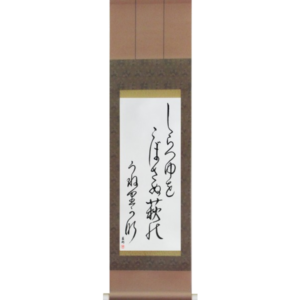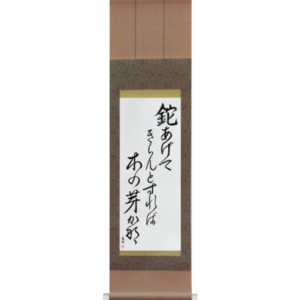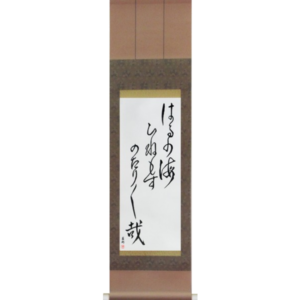H3022 Haiku by Basho – Shake even the grave …
by Master Japanese Calligrapher Eri Takase
Shake even the grave,
My wailing is
the autumn wind [1]
|
tsuka mo ugoke waga naku koe wa aki no kaze |
塚も動け 我が泣聲 は秋の風 |
| bashou | 芭蕉 |
Basho wrote this lamenting the death of his friend Issho – a man of talent who died before his time.
From the sampling of translations below you can see there are two general interpretations of this haiku. Some use words like “crying” and “weeping” – as if Basho’s felt a relatively quiet sadness or sorrow. Dumoulin writes, “Death and birth alike belong to the life that comes from nature and is reabsorbed by nature. In many songs Basho develops variations on the motif of the autumn wind. When he mourns the death of his young poet friend Issho, the autumn wind breathes the pure sorrow of death”. [2]
Others use “wailing” and “crying voice” to show there is a deeper emotion than simply sorrow and sadness – there is anger, there is bitterness, and there is frustration – Basho’s grief is a cold, biting wind that should shake the earth itself!
Miyamoto writes, “This verse is an elegy of Issho, a poet of Kanazawa who, although not a personal pupil of Basho, had a warm admiration for him and his poetry. He was comparatively young, but evinced a remarkable poetic talent. Therefore Basho deeply lamented his premature death, and his feelings were powerfully excited. The result was this verse, which means :- “the autumn wind is my lamentation; therefore, grave-mound, move with it!” What a violent outburst of grief! Perhaps none but poets of Basho’s genius and sincerity can think of such impressive symbolism.” [3]
Asataro Miyamori suggests the translation:
Oh, grave-mound, move!
My wailing is the autumn wind. [3]
Minoru Toyoda suggests the translation:
Shake! O tomb!
The sound of my wailing
Is the wind of autumn! [4]
Hoffman suggests the translation:
Move, O tomb,
the sound of my weeping,
is the wind of autumn. [5]
Nelson and Saito suggest the translation:
Mound, Oh Move!
My crying voice is
The autumn wind. [6]
Blyth suggests the translation:
Shake, oh tomb!
My weeping voice
Is the wind of autumn. [7]
and
Shake, oh grave!
The autumn wind
Is the voice of my wailing. [8]
Calligraphy Notes:
1) In older works, one most commonly sees waga written as a single kanji 我. The modern form adds the hiragana が which makes it 我が. As an example, Miyamori has 塚も動け我泣聲は秋の風 [3] and Blyth has 塚も動け我が泣聲は秋の風. [7] We consider both to be correct and use both.
Translation Notes:
塚も動け
我が泣聲
は秋の風1) 塚 (tsuka) means “(1) mound; heap; hillock; (2) burial mound; tomb; tumulus; barrow;”. The particle も (mo) means “also” or “even”. This is important and is not reflected, in our opinion, in most of the translations. We capture this by using “even” as in “shake even the grave” 塚も動け. Basho is angry at the world.
2) 動け (ugoke) is the imperative form of 動く (ugoku) meaning “to move”.
3) 我が (waga) means “my; one’s own; our”. As a fun fact, by itself 我 has eight different readings!
4) 泣聲 (naku koe) would today be written 泣き声 (nakigoe) meaning “cry; crying voice”.
5) 秋の風 (aki no kaze) meaning “autumn wind” is composed of 秋 (aki) meaning “autumn” and 風 (kaze) meaning “wind”.
References:
[1] Translation by Timothy L. Jackowski, Takase Studios, LLC.
[2] 351.
[3] 177.
[4] 131.
[5] 202.
[6] 155.
[7] 24.
[8] 82, 199.





